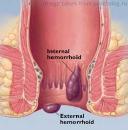
Digestion & Digestive Health - Hemorrhoids
Hemorrhoids - Causes Symptoms and Treatment
Hemorrhoids or haemorrhoids, are normal vascular structures in the anal canal which help with stool control. An exact definition of hemorrhoids does not exist, but they can be described as masses or clumps ("cushions") of tissue within the anal canal that contain blood vessels and the surrounding, supporting tissue made up of muscle and elastic fibers.
Causes of Hemorrhoids
Increased pressure in the veins of the anorectal area leads to hemorrhoids. This pressure may result from pregnancy, frequent heavy lifting, or repeated straining during bowel movements (defecation). In a few people, hemorrhoids develop from increased blood pressure in the portal vein.
By far the most common cause of hemroids is constipation. Constipation may contribute to straining. This can be as a result of a number of factors, notable among which is poor diet. A diet lacking in sufficient fibrous content and water can lead one to developing hemroids. Hemroids also develop as a result of overweight or obesity. An obese person exerts a lot of weight on the lower abdomen and this leads to excessive pressure building up in the anal system. Excessive pressure is also required by such a person to pass even small amounts of stool. Such amounts of pressure repeatedly applied will eventually cause the anal veins to swell and in turn constrain the process of passing stool. This vicious circle gives rise to hemroids in the long run. In the same way, people who lift heavy loads and pregnant women are also susceptible to hemroids because of pressure build-up in the lower abdomen.
In the same way, people who lift heavy loads and pregnant women are also susceptible to hemroids because of pressure build-up in the lower abdomen.
Symptoms & Diagnosis of Hemorrhoids
External hemorrhoids form a lump on the anus. If a thrombus forms (thrombosed external hemorrhoid), the lump becomes quite painful and more swollen. Internal hemorrhoids often do not cause a visible lump or pain, but they can bleed. Bleeding from internal hemorrhoids typically occurs with bowel movements, causing blood-streaked stool or toilet paper. The blood may turn water in the toilet bowl red. However, the amount of blood is usually small, and hemorrhoids rarely lead to severe blood loss or anemia.
Hemorrhoids may discharge mucus and create a feeling that the rectum is not completely emptied after a bowel movement. Itching in the anal region (pruritus ani) is usually not a symptom of hemorrhoids, but itching may develop if hemorrhoids make proper cleaning of the anal region difficult.
Right from its early stages hemroids symptoms are not difficult to diagnose. However caution should be exercised in doing so in order not to confuse other ailments like abscess or herpes with hemroids. Some of the tell-tale signs of hemroids are:
- An inflamed and itchy anus.
- Swollen veins inside the anal canal. The anal canal is the last four centimeters through which stool passes as it goes from the rectum to the outside world. The anus is the opening of the anal canal to the outside world.
- Stool stained with blood. This results from friction between hard stools and the anal walls.
- Prolapsed tissue from the anus. This is especially observable in later stages of internal hemroids.
A doctor can readily diagnose swollen, painful hemorrhoids by inspecting the anus and rectum. An examination with an anoscope (a short, rigid tube used to view the rectum) or sigmoidoscope (a flexible tube used to view the lower portion of the large intestine, the rectum, and the anus) helps a doctor determine whether the person has a more serious condition, such as a tumor. People who have bleeding from the rectum often require a sigmoidoscopy or colonoscopy.
Treatment
Usually, hemorrhoids do not require treatment unless they cause symptoms. It is believed generally that constipation and straining to have bowel movements promote hemorrhoids and that hard stools can traumatize existing hemorrhoids. It is recommended, therefore, that individuals with hemorrhoids soften their stools by increasing the fiber in their diets. Fiber is found in numerous foodstuffs including fresh and dried fruits, vegetables, grains, and cereals. Supplemental fiber (psyllium, methylcellulose, or calcium polycarbophil) also may be used to increase the intake of fiber. Stool softeners and increased drinking of liquids also may be recommended. Nevertheless, there is no strong, scientific support for the benefits of fiber, liquids, or stool softeners. Diarrhea is believed to aggravate the symptoms of hemorrhoids and it is recommended that diarrhea be controlled with fiber and anti-motility drugs.
Symptoms can sometimes be relieved by soaking the anus in warm water in what is known as a sitz bath. The soaking is accomplished by squatting or sitting in a partially filled tub or using a container filled with warm water placed on the toilet bowl or commode.
Bleeding hemorrhoids can be treated with an injection of a substance that causes the hemorrhoids to become obliterated with scar tissue. This procedure is called injection sclerotherapy.
Large internal hemorrhoids and those that do not respond to injection sclerotherapy can be tied off with rubber bands (a procedure called rubber band ligation). The band causes the hemorrhoid to wither and drop off painlessly. The treatment is usually applied to one hemorrhoid at a time at intervals of 2 weeks or longer. Internal hemorrhoids may also be destroyed with a laser (laser destruction), an infrared light (infrared photocoagulation), or an electrical current (electrocoagulation).